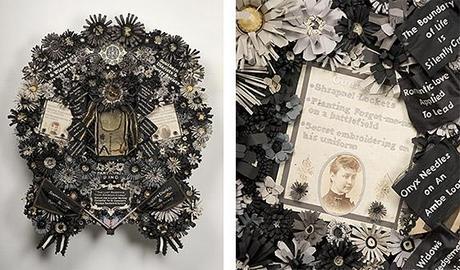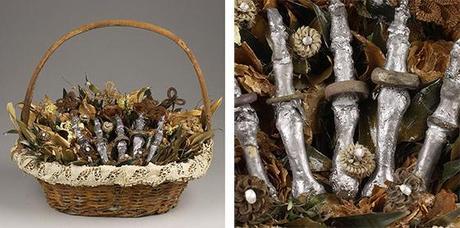In conjunction with our exhibition, The Civil War and American Art, the museum has invited four contemporary artists to discuss "Why the Civil War Still Matters to American Artists." This panel discussion will be moderated by Senior Curator Eleanor Harvey on Wednesday, March 13 at 4 p.m. in the museum's McEvoy Auditorium. Harvey had a chance to speak with one of the artists about his work: Dario Robleto.

Dario Robleto, The Southern Diarists Society, 2006, 45 x 37 x 6 in., Homemade paper (pulp made from brides' letters to soldiers from various wars, ink retrieved from letters, cotton), colored paper, fabric and thread from soldiers' uniforms from various wars, hair flowers braided by war widows, mourning dress fabric, silk, ribbon, lace, cartes de visite, antique buttons, excavated shrapnel and melted bullet lead from various battlefields
Eye Level: You title your body of work "An Instinct Toward Life" (and detail), and in those artworks you deal with experiences of trauma and loss, but also the endurance of the human spirit. Can you talk a bit about how you went about embedding those experiences in these works?
Dario Robleto: I am a big believer in using the actual materials of war when trying to address such a difficult topic. Referencing just doesn't cut it for me. So there is a literal embodiment, at a material level, of the very substances that caused the trauma or loss but also the redemption. Things like excavated bullet lead, that more than likely caused a wound, but also things like lockets of hair that would be braided into elaborate "hair flowers" or mourning jewelry, that were efforts by the families of the lost to somehow mourn, and, most importantly, remember the loved one. Beyond the materials, the historical stories I made sculptural responses to were ones that reflected this spirit of survival and endurance. Stories often forgotten about in the larger narratives of war. Things like how a whole generation of men in the Civil War, who had just experienced an unprecedented level of war related amputations, would respond to the simple act of wanting to walk your daughter down the wedding aisle. How they did respond, and pointing the spotlight on moments like that, embody an important part of remembering the war as much as any statistic will reveal.
EL: What drew you to this topic, and these materials—Civil War prosthetics, human bones, glass eyes, medical implements, war-related ribbons and photographs, and the like?
DR: After 9/11 my work made a drastic shift in focus. Everyone remembers the question in the immediate aftermath was "why?" As an artist I had to ask some serious questions about what the role of the artist and art was in a moment like this. Could art say anything meaningful in the face of such tragedy? Of course [Arthur] Danto gave this point a new kind of urgency in the face of the Holocaust but I needed to know for myself and if anything had changed since that horrible moment. I decided that I would not look away from the problem until I felt I had got somewhere. I had no idea that over 10 years later, and several dozens of works, I would still be clawing away at it. Of course, now I realize probably nothing less than a lifetime should be devoted to such questions. One of the handful of points I feel I understand better is that if you are going to talk about war in any serious and respectful way I feel you cannot blink or look away from the actual realities of the battlefield. And one of those realities is that the destruction of the body and the mind can be so devastatingly complete that only dust is left. No other solution seemed right except to account for that dust as an actual material in the work. There can be the hope that the poetic can act as some sort of balm to the wounds of war, but when it came to selecting materials I felt there was no hope for emotional honesty unless you use the actual materials of war.

Dario Robleto, No One Has a Monopoly Over Sorrow (and detail), 2005, 10 x 11 x 8 in., Men's wedding ring finger bones coated in melted bullet lead from various American wars, men's wedding bands excavated from American battlefields, melted shrapnel, wax-dipped preserved bridal bouquets of roses and white calla lilies from various eras, dried chrysanthemums, male hair flowers braided by a Civil War widow, fragments from a mourning dress, cold cast brass, bronze, zinc, silver, rust, mahogany, glass
EL: How do you describe the distinction between memory and memorial?
DR: Memorials can allow us to preserve something, safely resting in the past. They allow us a place to focus our thoughts and emotions but with a growing distance from the present tense. This is very important for our needs to show respect and be reminded of others' struggles. But, and maybe this is a distinction that only matters when you're working in the field of memory, the living also need a type of memory that is active, that matters right now and tomorrow. This "active memory" is the type that matters to me day to day because I feel the responsibility, the urgency, to not drop the baton I feel is handed down over and over as an act of generational collaboration. So, in a sense, this type of memory never grows distant because it is affecting change right now.
EL: I love that your medium lines become complex narratives. How do you envision the relationship between the description of the work, and the work itself?
DR: I like to describe myself as a "materialist poet." I invented this term to better explain just how important the role of text is to my work. It is on absolute equal footing as the object. This is often misunderstood in my work as a distraction or somehow a weakness of the object that it needs this accompanying text. This is completely missing the point that the work is about the intersection of materials and language. In fact, language and poetry are so important that the majority of the time the title and material list lines come before the making of the object. I often have no idea what i'm going to make until I have completely worked out these short poems and they have satisfied me as language. For example "male wedding ring finger bones coated in melted bullet lead," is something written by me for the sake of language and then I find a way to give life to these words in materials and objects. So, for me, as the maker, one can't exist without the other. Some ways a viewer could choose to look at them are as short poems, abstract narratives, ingredient lists or liner notes and lyric sheets. I work hard on balancing them between literal descriptions and mystery and hopefully this tension raises even more questions in the viewer.
EL: What is the role of music in these war-themed pieces?
DR: My background as a passionate music fan and long investment in DJ culture informs all my work no matter the topic. The types of singers and music I am drawn to are the ones that evoke great emotional responses that at different moments in our lives can even be forms of survival. Anyone who has ever lost someone or been through a terrible break-up or fallen dangerously in love will understand the role music can play in keeping you moving forward. The power of music in letting you know you are not the only one who has ever felt this way will never loose its relevance in displaying the power of empathy. This thinking was vital to have in place when I began the war related work as another tool in trying to ask how art can help in any way to mend the emotional wounds of war.
EL: If you have a favorite piece, for whatever reason, which speaks to you most compellingly?
DR: Favorite is hard to say but the piece I grappled with the most is a piece called No One Has A Monopoly Over Sorrow. Because of the nature of the materials and the story that motivated the work, I had to dig deeper than ever before to ask if this was all worth it. Every artist needs to reach a moment when you honestly confront the purpose of what you are doing. If you cannot answer this then I think you should not continue. Especially on a topic such as war. This piece will always have a special connection to me because I felt I had to change if I was going to do it. It raised in me a question that I still use today and that has become a guiding principal for all my work which is, "What do I need to do to earn the respect of this material and story?" If I do not feel I have earned this respect then I will not proceed. How I earn it varies from each piece and is a long, personal answer that I wouldn't do justice to in this short space. But it is something I fight to earn everyday.

